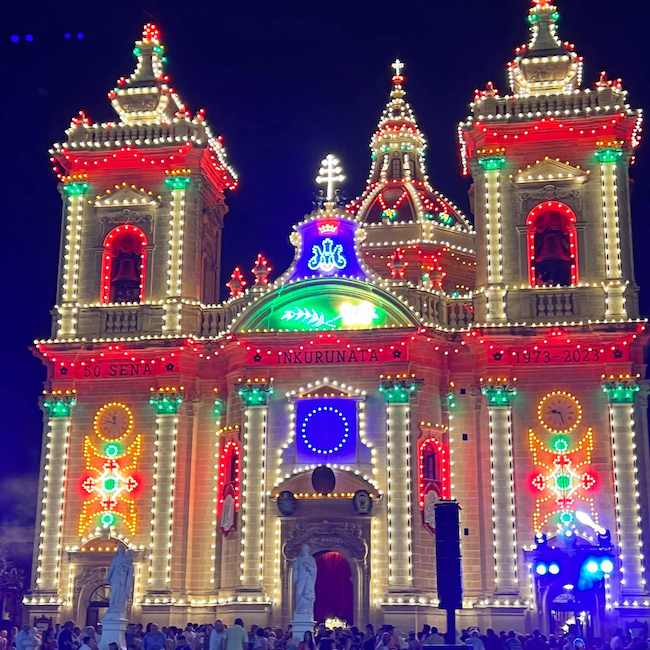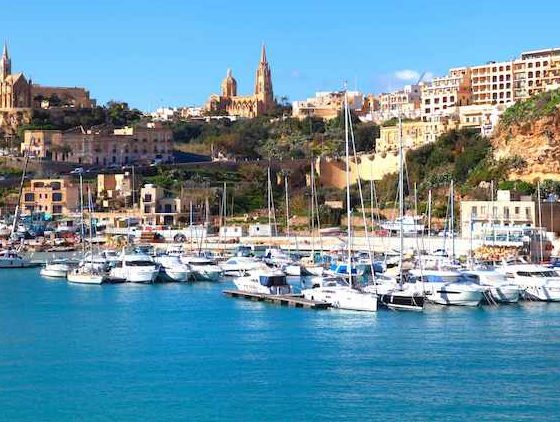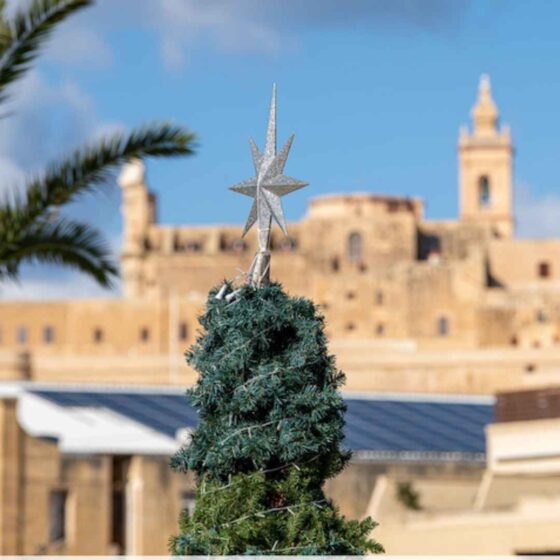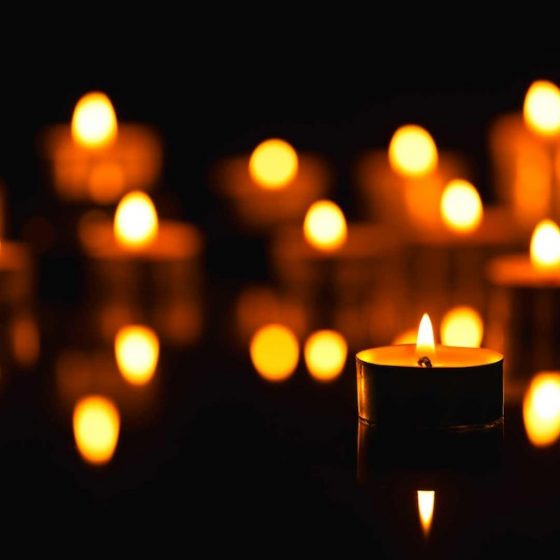Your Guide To The Biggest Village Feasts Celebrated On Gozo Island.
Feasts in Gozo are a festival for the senses. Make sure you experience at least one this year. Together with the sun’s warm rays caressing your skin, the delicious flavours of a cooling ice cream, and the inviting scent of the sea, you are also guaranteed a vision of multicoloured street banners, a myriad of musical notes from orchestras, accompanied by a cacophony of fireworks and boisterous cheers from across Gozo Islands town squares at one of the islands feasts.
Yes, it really isn’t summer without our beloved local festas and although Malta has a super choice, Gozo is also brimming with options.
Every year, townspeople around Malta and Gozo prepare an intense feast programme filled with activities centred around the particular Saint their church is named after. Solemn Masses are held alongside jolly parties and processions spilling out into the streets. Children throw confetti from beautifully decorated balconies, as street revellers belt out songs dedicated to their Saint and dance to the tunes played by their village band. The titular statue is carried high on shoulders through the streets until it is placed back inside the church, ready to go again the next year.
If you’re planning on crossing over to Gozo for an unforgettable bash, the following feast celebrations are definitely ones to watch out for!
- Your Guide To The Biggest Village Feasts Celebrated On Gozo Island.
- 1. June: Feast of St John the Baptist in Xewkija
- 2. 29th June: L-Imnarja – Feast of St Peter and St Paul, Nadur
- 3. July: Feast of St George Martyr in Victoria
- 4. 15th August: Santa Marija – Feast of the Assumption of Our Lady, Victoria
- 5. August: Feast of Our Lady of Loreto in Ghajnsielem
- 6. 8th September: Il-Vitorja – Our Lady of Victory, Xaghra (Nativity of Our Lady)
- 7. 8th December: Il-Kunċizzjoni – Feast of the Immaculate Conception, Qala and Victoria
1. June: Feast of St John the Baptist in Xewkija
A notable landmark on the Gozitan skyline—which can even be seen from across the channel—is the majestic dome of Gozo’s largest church in Xewkija, devoted to St John the Baptist. Inaugurated as the first countryside parish in 1678, the Rotunda also serves as the spiritual seat for the Sovereign Military Order of Malta, more commonly known as the Knights of Malta.
This Gozo feast falls on the Sunday closest to the 24th June, when St John the Baptist was born. The town’s roads are bedecked with splendid pavilions which complement the grandeur of the Rotunda. Various street celebrations culminate in the popular traditional Thursday march, when the townspeople are entertained by dazzling light shows and fireworks flaming the night skies.
The pièce de résistance—unique to Xewkija as well as the Maltese islands—is the magnificent umbrella spreading much-needed shade over the festivities in the village square. The 13-metre-high and 16-metre-wide structure is adorned with 20 ornamental flags depicting noted individuals connected with the parish and its feast, as well as a number of saints with whom St John interacted during his life.
The Xewkija population is also proud to host a second feast towards the end of August to mark the solemn day when the Baptist was martyred, making him the only saint whose birthday and death are both observed. Numerous daily activities—varying between prayer vigils and horse parades, as well as traditional music and local delicacies—conclude with the lighting of an impressive wood bonfire in front of the Rotunda.
Click here for a full list of local village festas in Gozo.
2. 29th June: L-Imnarja – Feast of St Peter and St Paul, Nadur
Hailed as one of the oldest Roman Catholic festivities, dating as far back as the 3rd century AD, the word Imnarja originates from the Latin ‘luminaria’, a pagan festival celebrating light. It later manifested into a Christian holiday honouring two important saints regarded as the light of the Church: St Peter and St Paul. Today, this date commemorates the martyrdom of these two saints while also headlining traditional and cultural events rejoicing in successful spring harvests, the end of the scholastic year for children, and the official start of summer.
In Malta, the areas around Rabat and Buskett Forest fill up with scores of people indulging in musical performances, agricultural exhibitions, horse and donkey races, and of course, copious amounts of local wine and food, predominantly featuring Malta’s signature rabbit dishes. In Nadur, however, the focus is more on the religious aspect of the feast—with good reason. St Paul is Malta’s patron saint—having brought Christianity to the islands after being shipwrecked here—while St Peter, as the patron saint of fishermen, is regarded highly within the local fishing industry.
Much like the other village festas, the majestic basilica in the Gozitan village—dedicated to these two revered saints—is host to a number of religious services marking their feast. Traditional processions—at times, with the titular statues carried by the village children—and colourful street marches form part of the preliminary programme leading up to the feast day. Other events include a traditional Imnarja dinner in the town square—a fun evening of delicious food, accompanied by singing and dancing—and an orchestral concert held in front of the church, with 3D projections illuminating the façade of the basilica and a stunning fireworks display synchronised with the musical notes.
The morning of the 29th June is then marked with a solemn Pontifical Concelebration led by Gozo’s Bishop, Anton Teuma, together with representatives from Nadur’s clergy and local religious delegates. After the evening vespers by the parish priest, the statues of the two saints pass through the streets in a procession accompanied by the melodic sounds of the Jubilate Deo choir. The feast ends with a sacramental blessing after the titular statues are returned to the Nadur Basilica.
Bigger And Better For 2025
156+ Page Digital Magazine + Map + Insider Tips + Food & Drink Stories + Travel Edits + Hidden Gems + Seasonal Events + Public Holidays + Handy Contacts + Experiences + More!
Want the printed version?

3. July: Feast of St George Martyr in Victoria
Set within the narrow streets of Gozo’s capital, a picturesque piazza is home to the elegant Basilica of St George Martyr. As the first parish established in Victoria, the “golden church of Gozo” once catered for the whole island’s Christian community. The stunning interiors of this religious building include artistic frescos adorning the walls and ceiling—and no less than eight side chapels extending from the main church.
The third Sunday in July is dedicated to this saint, although a separate commemoration for St George’s Day on 23rd April is also held in Gozo and worldwide. This July Gozo feast stands out in two aspects—while it has kept pace with the changing times over the years, it is the only local feast that retained the customary formula for the liturgical rituals held inside the Basilica. These include Eucharistic celebrations and vespers, the adoration of the saint’s reliquary, animated sermons, and orchestral recitals. The highlights of these religious rites are the jam-packed daily processions honouring St George, that see different statues of the saint escorted through the streets of Victoria while religious hymns are played by the La Stella Band.
Apart from these solemn holy observances, St George’s summer feast also involves three weeks of jubilant outdoor activities, among them horse races in the main streets, band marches and musical shows, the ringing of the church bells, partying crowds and traditional nougat stalls, and last but certainly not least, spectacular ground fireworks and earth-shaking petards.
4. 15th August: Santa Marija – Feast of the Assumption of Our Lady, Victoria
It is quite evident that Maltese and Gozitans cherish any occasion that honours their beloved Mother of God—and this is especially noticeable on the midsummer day that marks her Assumption. This popular feast on the 15th of August is celebrated in no less than eight parishes within the two main islands—namely, Attard, Birkirkara, Għaxaq, Gudja, Mosta, Mqabba, Qrendi, and Gozo’s capital, Victoria. The day is also eagerly awaited by many locals as businesses shut down their operations for the whole week to offer their workforce a well-deserved summer break, with many flocking to Gozo for their yearly staycation.
This date not only honours Mary’s ascent into Heaven, but it is also connected to the history of Malta towards the end of World War II. In August 1942, facing the possibility of having to surrender to the enemy due to lack of vital supplies, the populace prayed fervently for the safe arrival of the dispatched fleet of fully stocked ships, which suffered significant attacks on their way to the islands. Finally, in the week of Santa Marija, part of the battered convoy sailed into Grand Harbour—extensively damaged, but transporting the much-needed food and fuel supplies to the Maltese. This event was considered a miraculous answer to the people’s prayers!
The date honouring Our Lady has, however, been observed in Gozo since the early 1700s, long before any of the global wars. The Cathedral at Victoria’s medieval Citadel is, indeed, the place to be for the Santa Marija festivities. The beautifully adorned statue is paraded high on parishioners’ shoulders during a street procession led by Gozo’s Bishop, with astounding pyrotechnics displays illuminating the skies as it exits and enters the church. The highlight of this parade culminates in the crowds carrying the statue up the stairs of the Cathedral as they return the revered figure to its rightful place.
Other spectacular events organised for the benefit of the thousands of locals attending this massive feast include traditional horse races along the main street of the capital city, an agricultural fair within the picturesque gardens at Villa Rundle, concerts and band marches by the Leone Philharmonic Society brass band, and various street celebrations and solemn rituals.
5. August: Feast of Our Lady of Loreto in Ghajnsielem
The towering Gothic church in Ghajnsielem was constructed in the early 1900s to replace the preceding smaller parish. It took over half a century to complete, in spite of the multiple resources donated by the villagers themselves. Perhaps this is why, today, Ghajnsielem residents sing loud and proud as they commemorate their revered Lady of Loreto, or as she is more affectionately known, Ix-Xemx (the sun).
The Ghajnsielem feast in Gozo occurs on the last Sunday in August, but festivities commence over a week earlier. The packed daily timetable alternates the obligatory church ceremonies with family events, outdoor parties, and several street processions, with the crowds wearing identical blue t-shirts designed with images of Our Lady. The popular song ‘Viva ix-Xemx’ and other favourites are chanted to the accompaniment of the brass band.
The Friday night Balzunetta includes an amusing practice dating back to the 1980s, when some youths all turned up dressed in the same material. This unusual idea was soon adopted by the whole village and now serves as a fundraising initiative to cover the annual expenses. Every summer, the organising body, L-Għaqda tal-Armar, procures a roll of fabric with a different pattern each year. The people then buy pieces of the material and create outfits or accessories to wear on the night. Some sew dresses, tops, shorts, or waistcoats; others create hairbands or bandanas—or even a cute neck scarf for their dog!
This is, however, only one of this popular Gozo event’s unique characteristics. To keep themselves hydrated in style, the Għajnsilmiżi poke straws into large watermelons infused with their favourite cocktails to ensure they do not miss a single second of entertainment queueing up at the bar.
Additionally, when the Friday procession arrives at the church square, the statue of the Madonna of Loreto, the patron saint of aviation, is not lifted onto its pedestal in the normal way. Instead, it is attached to one end of a zip-line extending across the parvis. The statue slides slowly across, suspended over the heads of the enthusiastic parishioners as they serenade their beloved Xemx. To complete the aviation theme, fire-planes shoot across the same path, as colourful fireworks boom in the sky.
6. 8th September: Il-Vitorja – Our Lady of Victory, Xaghra (Nativity of Our Lady)
The most befitting way of honouring Our Lady must surely include a festa dedicated to her birthday—namely, the 8th of September. Nevertheless, this date also happens to coincide with a national holiday known as Il-Vitorja, which marks the end of two significant and bloody conflicts that severely affected the Maltese islands: the Great Siege of 1565 and the Second World War attacks on the country in the 1940s.
The September feast, therefore, remembers the date of Mary’s birth, together with the days when the islands were reborn, honouring her both as Il-Bambina—the Little Newborn Baby—and Our Lady of Victory, whom the Maltese regularly sought in prayer to save them from these historical times of crisis.
The traditional and cultural aspect of this feast is evident in the yearly—and fiercely competitive—regatta boat races hosted in Valletta’s Grand Harbour. Additionally, religious feasts are held in a number of local towns; among them, the Gozitan village of Xaghra, whose church is dedicated to the Marija Bambina.
Daily Masses and intercessory prayers accompany the novena prayed to Our Lady in the run-up to the feast, each day being dedicated to a particular intention, among them priests, vocations, social organisations, village natives, youths, the sick, and various ministries within the parish. Choirs, orchestras, and soloists offer up musical accompaniments amid other outdoor festivities, including band marches, bingo in the square, traditional outdoor dinners, horse races in the main road between Xaghra and Victoria, and of course, the obligatory aerial firework extravaganzas.
On the feast day itself, the Xaghra Historical Re-Enactment Organisation, in conjunction with the local council, presents re-enacted scenes from the Great Siege and World War II in the main square, followed by the laying of wreaths in front of a commemorative monument set up for the occasion. The Maltese National Anthem is then performed before the procession with the titular statue rounds off the festivities.
7. 8th December: Il-Kunċizzjoni – Feast of the Immaculate Conception, Qala and Victoria
Although this feast risks being overshadowed by the numerous Christmas activities tussling for the spotlight throughout the month of December, the 8th of this month is marked in a special way as the day when Our Lady was conceived in a pure and sinless state—a dogma proclaimed as highly crucial to Roman Catholicism by Pope Pius IX in 1854. In Gozo, both the towns of Victoria and Qala mark this day so cherished by Catholic believers—also one of the much-awaited public holidays in the last month of the year.
The island’s capital, Victoria, organises several commemorative festivities for the occasion. Holy Masses are held in the church dedicated to St Francis of Assisi, both on the eve and on the day itself. The concelebrated Masses involve the Gozitan Bishop, the Franciscan friars, and other members of the clergy, with singing by various choirs accompanying the devout rituals and prayers. The main highlight involves the parading through the streets of the beautiful statue of the Blessed Virgin—carved in wood by local sculptor, Salvatore Psaila, back in 1848.
In Qala, although not the main parish, a humble but intricately decorated chapel dedicated to the Immaculate Conception lies on the side of a country road overlooking the other islands. Built in 1575, the chapel is one of Gozo’s earliest Marian shrines and even served as Qala’s parish until the late 1800s. In spite of the building’s smaller size, the December festa is still memorialised with the same pomp and passion encountered in other localities. The statue found here originated from Marseilles, sculpted by Gallard et Fils in 1887.
One unusual activity connected to the Qala feast day is a yearly motorcade in the early afternoon, commencing from the notable Ta’ Pinu Sanctuary just outside Għarb and driving all the way to the Qala chapel. The parish priest blesses the group of motorcyclists and drivers one by one before they set off on this unique pilgrimage in honour of Our Lady Immaculate. Masses by the Bishop and the town’s parish priest are followed by Eucharistic rites and prayers, with vibrant fireworks closing off the religious ceremonies with dramatic flair.
If there is one thing you can be sure of, it’s that Gozitans love to party!
So, come join in the fun atmosphere and joyous merrymaking at one of these festive occasions that make summers in Gozo truly remarkable—along with a sprinkling of jubilation during the other seasons too! Check the FULL LIST of feasts here.
Bigger And Better For 2025
156+ Page Digital Magazine + Map + Insider Tips + Food & Drink Stories + Travel Edits + Hidden Gems + Seasonal Events + Public Holidays + Handy Contacts + Experiences + More!
Want the printed version?





